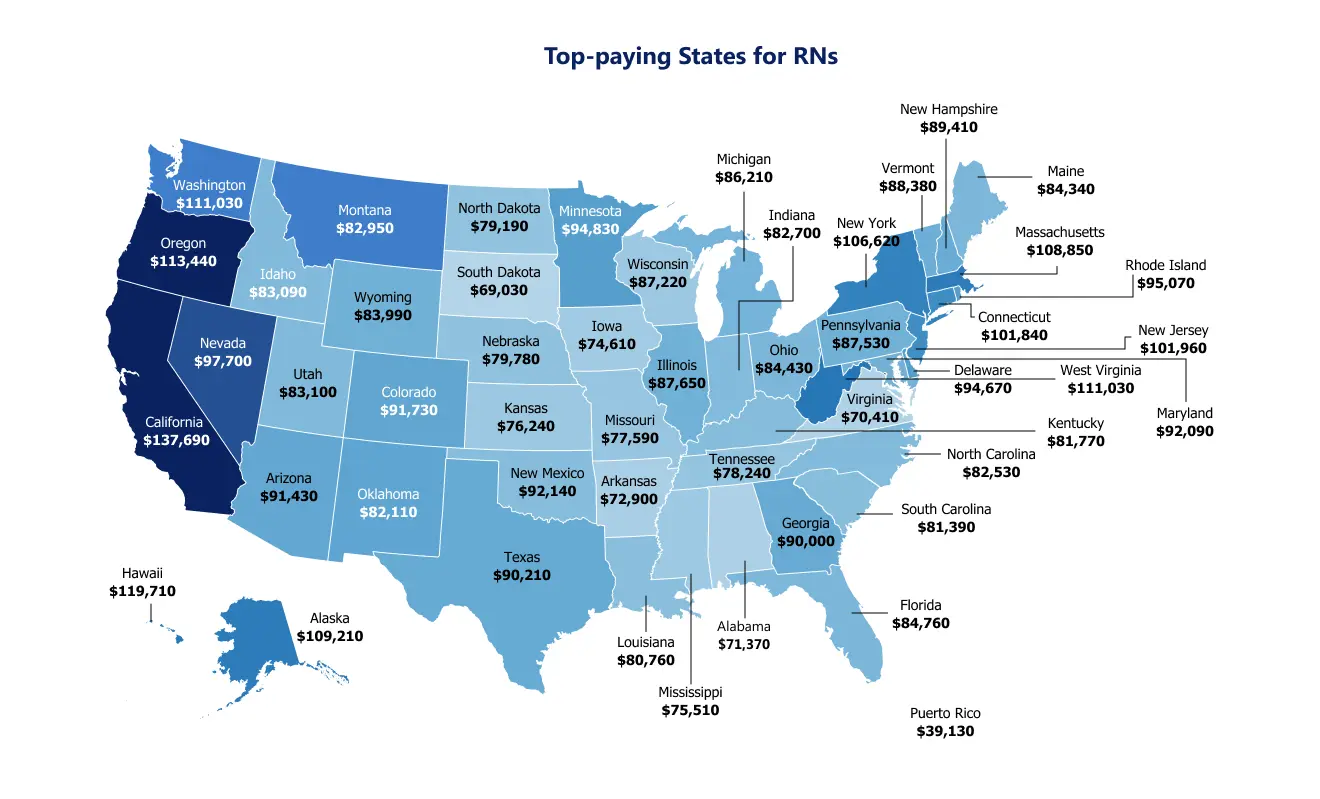Nursing Statistics 2024
The latest nursing statistics presented here offer a comprehensive and enlightening look into the world of nursing.

Nursing is a profession that is widely recognized for its unwavering compassion, professionalism, and positive impact on society. Nurses have held the highest ethical standards among various professions for over two decades, earning the trust of 79% of U.S. adults. This level of trust is a testament to the dedication and compassion that nurses bring to their work, as they play a critical role in protecting the well-being of individuals and communities.
The latest nursing statistics gathered from reputable sources and presented here offer a comprehensive and enlightening look into the world of nursing. From demographic to educational trends, employment dynamics, workplace, and mental health, these data equip you with a deeper understanding of nurses’ priceless work and the evolving landscape in which they operate.
Key Takeaways
- There are 5.2 million RNs and 973,788 LPNs/LVNs in the United States.
- According to the latest nursing statistics, the median annual salary for registered nurses is $81,220.
- A 6% employment growth in nursing is projected to happen from 2022 to 2032.
- Nurses earn an average of approximately $39.05 per hour.
- Nurses’ ethical prowess holds steady at 79%.
- Female nurses maintain a strong majority, with 88.5%.
- RN male nurses represent 11.2% of the nursing workforce.
Topics Covered
Nursing Demographic
Statistics
Nursing Education
Statistics
Nursing Employment
Statistics
Nursing Salary
Statistics
Nursing Job Satisfaction
and Mental Health
Nursing Demographic Statistics
Nursing is the nation’s largest healthcare profession, with 5.2 million registered nurses (RNs) nationwide.
Although the traditionally female-dominated nursing profession is seeing an increase in male nurses, female nurses continue to maintain the majority.
Nursing statistics by gender
According to the latest data, male nurses represent 11.2% of the RN workforce in the U.S., an increase from 8.0% in 2015.
This rise suggests a breakthrough in this female-dominated profession.
However, female nurses remain a substantial majority, comprising 88.5% of the RN workforce in 2022.
In addition, the nonbinary category accounts for a modest 0.3% of responses in 2022 (up from 0.1% in 2020).
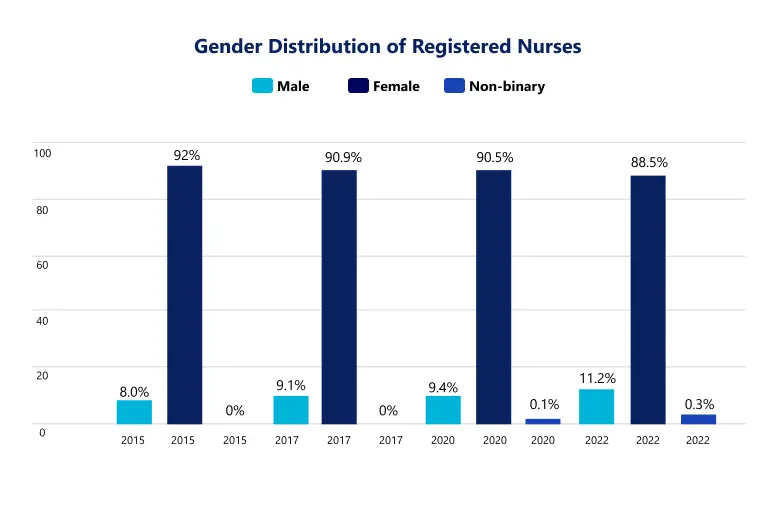
Nursing Demographic Statistics
Nursing is the nation’s largest healthcare profession, with 5.2 million registered nurses (RNs) nationwide.
Although the traditionally female-dominated nursing profession is seeing an increase in male nurses, female nurses continue to maintain the majority.
Nursing statistics by gender
According to the latest data, male nurses represent 11.2% of the RN workforce in the U.S., an increase from 8.0% in 2015.
This rise suggests a breakthrough in this female-dominated profession.
However, female nurses remain a substantial majority, comprising 88.5% of the RN workforce in 2022.
In addition, the nonbinary category accounts for a modest 0.3% of responses in 2022 (up from 0.1% in 2020).

Nursing statistics by age
RNs are distributed across various age groups within the nursing profession.
The largest percentage is evenly split between two distinct age cohorts: 30 to 34 years and those 65 years or older, with each group comprising 13.2% of the workforce.
This reflects a balanced representation of both experienced, seasoned nurses and younger counterparts.
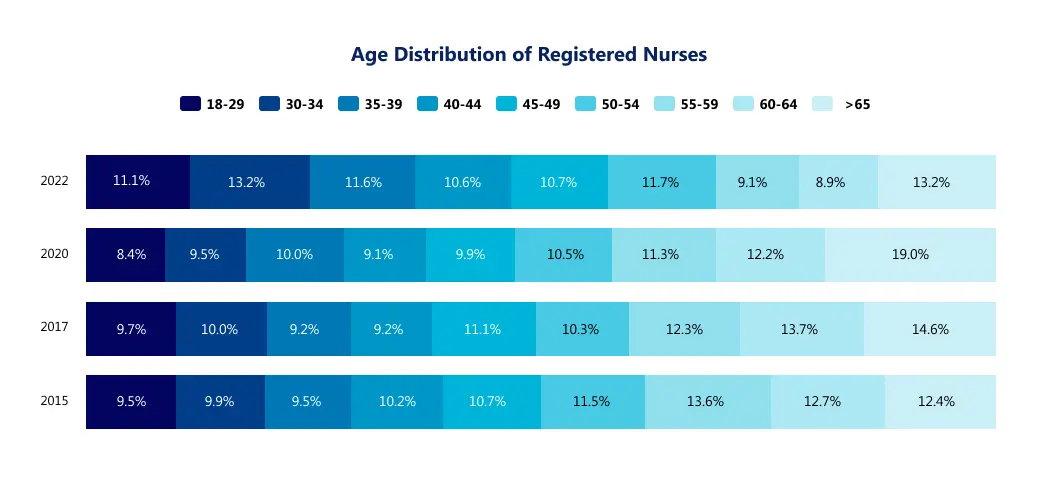
Nursing statistics by age
RNs are distributed across various age groups within the nursing profession.
The largest percentage is evenly split between two distinct age cohorts: 30 to 34 years and those 65 years or older, with each group comprising 13.2% of the workforce.
This reflects a balanced representation of both experienced, seasoned nurses and younger counterparts.
Nursing statistics by race
The data reveals a remarkable consistency in the racial demographics over five years.
White/Caucasian individuals have consistently comprised the most significant percentage of RNs nationwide, with 80.8% in 2017, 80.6% in 2020, and 80% in 2022.
Although at a much lower percentage, the Asian group is second on the list, with 7.5%, 7.2%, and 7.4%, followed by Black/African American representation, with around 6%, during the same years.
While the White/Caucasian and the Asian categories saw a minor decrease from 2017 to 2022, nurses who identified as Black/African American slightly increased from 6.2% to 6.3%.
Over the same time, the multiracial category increased from 1.7% to 2.5%.
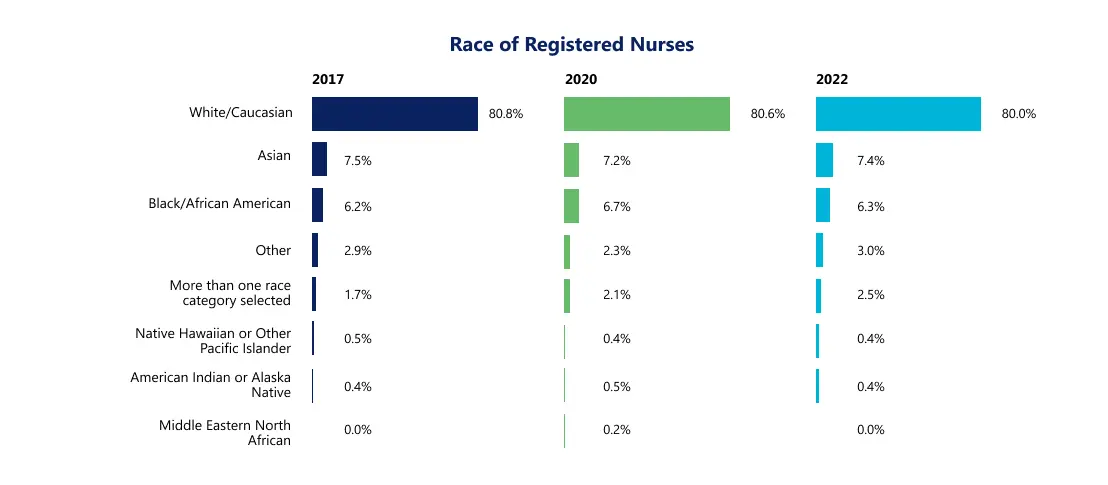
Nursing statistics by race
The data reveals a remarkable consistency in the racial demographics over five years.
White/Caucasian individuals have consistently comprised the most significant percentage of RNs nationwide, with 80.8% in 2017, 80.6% in 2020, and 80% in 2022.
Although at a much lower percentage, the Asian group is second on the list, with 7.5%, 7.2%, and 7.4%, followed by Black/African American representation, with around 6%, during the same years.
While the White/Caucasian and the Asian categories saw a minor decrease from 2017 to 2022, nurses who identified as Black/African American slightly increased from 6.2% to 6.3%.
Over the same time, the multiracial category increased from 1.7% to 2.5%.
Nursing Education Statistics
According to the latest data, the nursing profession has experienced a shift in educational preparation.
From 2015 to 2022, the number of nurses with bsn and master’s degrees has significantly increased.
The percentage of baccalaureate degrees increased from 43.4% in 2015 to 51.1% in 2022, and at the same time, that of master’s degrees has grown from 15.8% to 17.9%.
While the number of nurses with a PhD remains steadfast at 0.9%, the number of those with a DNP degree has increased, rising from 0.6% to 1.6%.
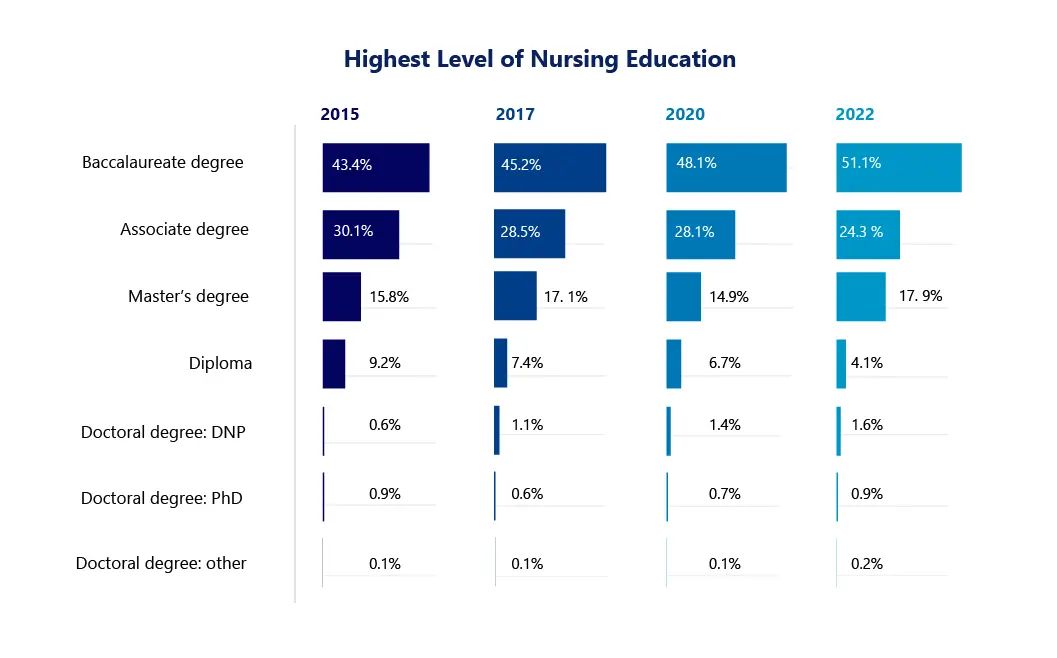
On the other hand, the percentage of nurses acquiring RN diplomas declined from 9.2% to 4.1% between 2015 and 2022.
Similarly, the number of associate degrees in nursing also decreased, dropping from 30.1% in 2015 to 24.3% in 2022.
Nursing Education Statistics
According to the latest data, the nursing profession has experienced a shift in educational preparation.
From 2015 to 2022, the number of nurses with baccalaureate and master’s degrees has significantly increased.
The percentage of baccalaureate degrees increased from 43.4% in 2015 to 51.1% in 2022, and at the same time, that of master’s degrees has grown from 15.8% to 17.9%.
While the number of nurses with a PhD remains steadfast at 0.9%, the number of those with a DNP degree has increased, rising from 0.6% to 1.6%.
On the other hand, the percentage of nurses acquiring RN diplomas declined from 9.2% to 4.1% between 2015 and 2022.
Similarly, associate degrees in nursing education also experienced a decrease, dropping from 30.1% in 2015 to 24.3% in 2022.
Nursing Employment Statistics
Nursing employment today is marked by an increase in full-time positions, reflecting a growing commitment to the profession.
The percentage of RNs currently engaged in full-time nursing roles represents the highest level since 2015.
The vast majority of RNs, around 88.9%, are actively employed in the nursing field. Notably, 70.2% work full-time, a 5.3% increase compared to 2020.

In 2022, the proportion of unemployed RNs actively seeking nursing work experienced a slight decrease to 2%, down from 2.3% in 2015.
Simultaneously, the percentage of RNs unemployed and not seeking nursing work dropped from 3.5% in 2015 to 2.6% in 2022.
Unemployment reasons
Currently, the most commonly cited reason for unemployment among nurses is the responsibility of caring for home and family, as reported by 46.8% of RNs.
Additionally, approximately 22% attribute their lack of employment to the ongoing COVID-19 pandemic, and nearly 12% point to inadequate pay as the primary reason.
Meanwhile, 10.7% of RNs report being unemployed due to the difficulty in finding positions in nursing.
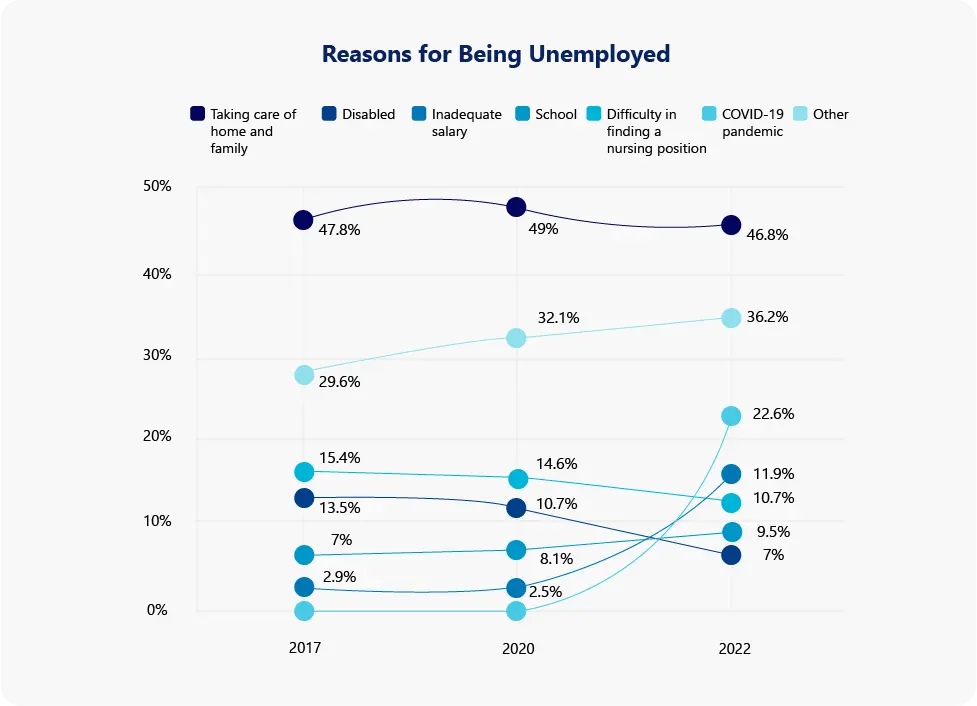
Unemployment reasons
Currently, the most commonly cited reason for unemployment among nurses is the responsibility of caring for home and family, as reported by 46.8% of RNs.
Additionally, approximately 22% attribute their lack of employment to the ongoing COVID-19 pandemic, and nearly 12% point to inadequate pay as the primary reason.
Meanwhile, 10.7% of RNs report being unemployed due to the difficulty in finding positions in nursing.
Nursing practice position setting
Hospitals remain the dominant practice setting for nurses.
In 2022, 57.5% of RNs reported hospitals as their primary setting of practice, an increase from 54.4% in 2015.
On the other hand, data reveals a decline in nursing home/extended care and home health services.

Nursing home/extended care practice dropped from 4.8% in 2015 to 3.9% in 2022, while home health services decreased from 6.1% to 3.4% in the same period.
Nursing Salary Statistics
According to the latest nursing statistics, the median annual salary for RNs is $86,070, or $41.38 per hour.
Furthermore, data projects a 6% employment growth from 2022 to 2032, with a need for at least 193,100 new nurses annually.
Top-paying industries
Federal, State, and Local Government, excluding State and Local Government Schools and Hospitals and the U.S. Postal Service (OEWS Designation), is the top-paying industry for RNs, offering an impressive annual mean wage of $114,860. Next on the list is Employment Services, followed by the Pharmaceutical and Medicine Manufacturing industry.
The top-paying industries are as follows:
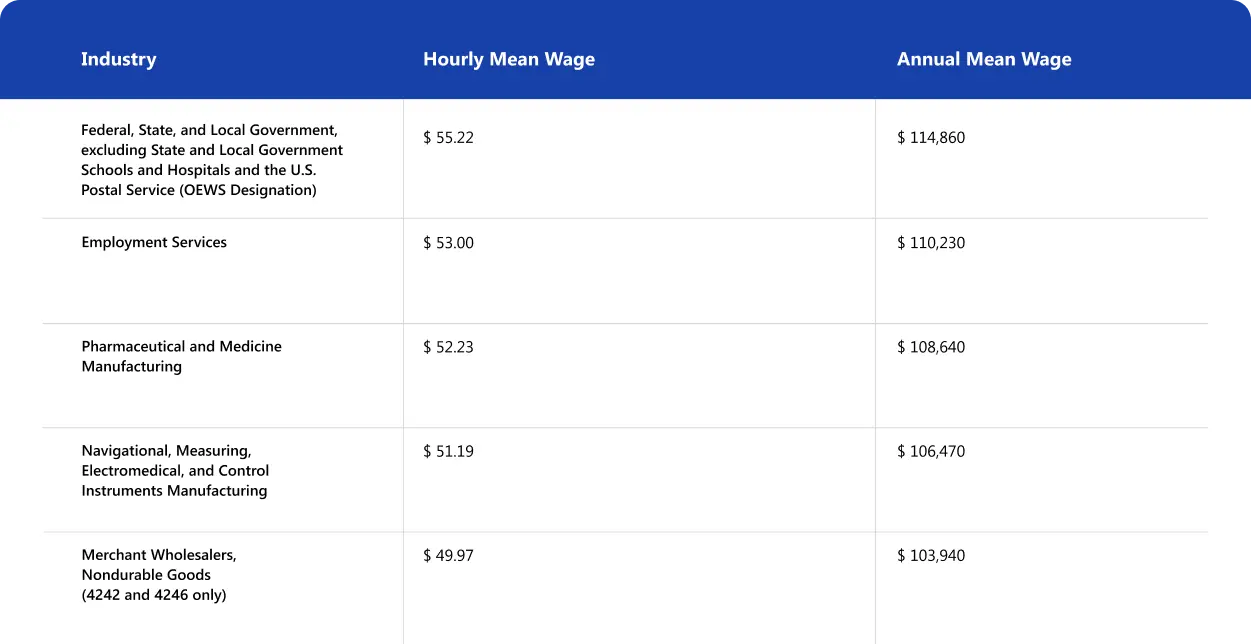
Nursing Salary Statistics
According to the latest nursing statistics, the median annual salary for RNs is $86,070 per year or $41.38 per hour.
Furthermore, data projects a 6% employment growth from 2022 to 2032, with a need for at least 193,100 new nurses annually.
Top-paying industries
Federal, State, and Local Government, excluding State and Local Government Schools and Hospitals and the U.S. Postal Service (OEWS Designation), is the top-paying industry for RNs, offering an impressive annual mean wage of $114,860. Next on the list is Employment Services, followed by the Pharmaceutical and Medicine Manufacturing industry.
The top-paying industries are as follows:
Top-paying states
The nursing profession offers a variety of income levels across the United States, and certain states stand out as particularly lucrative for RNs. California leads the nation with the highest annual mean wage for RNs, boasting an impressive figure of $137,690.
Hawaii is a close second, providing RNs with an annual mean wage of $119,710. Oregon, Washington, and Alaska also rank among the top states for RN earnings, with average salaries of $113,440, $111,030, and $109,210, respectively.
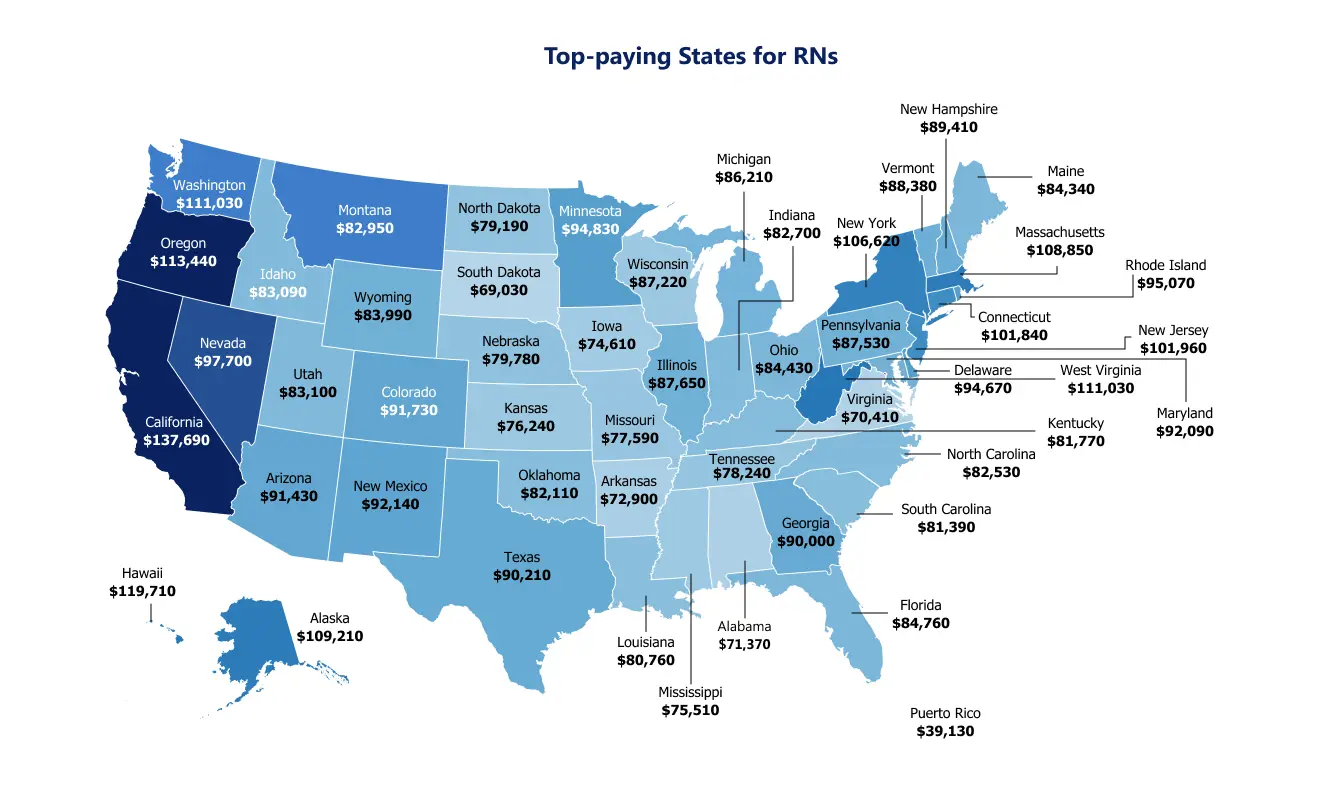
Top-paying states
The nursing profession offers a variety of income levels across the United States, and certain states stand out as particularly lucrative for RNs. California leads the nation with the highest annual mean wage for RNs, boasting an impressive figure of $137,690.
Hawaii is a close second, providing RNs with an annual mean wage of $119,710. Oregon, Washington, and Alaska also rank among the top states for RN earnings, with average salaries of $113,440, $111,030, and $109,210, respectively.
Salaries by education level
Nurses with higher-level degrees experience, on average, higher median wages. RNs with a Doctor of Nursing Practice (DNP) degree enjoy the highest reported annual earnings, with a median salary of $110,000 per year.
RNs with a Ph.D. report a median annual salary of $105,000, while those with another type of doctorate or a master’s earned $100,000. RNs with bachelor’s degrees earned $75,000.
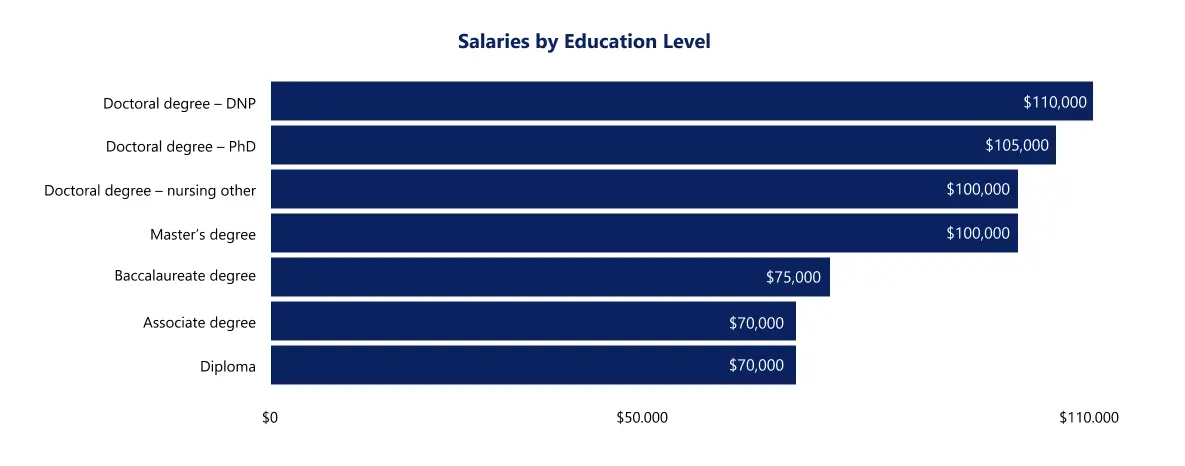
Salaries by education level
Nurses with higher-level degrees experience, on average, higher median wages. RNs with a Doctor of Nursing Practice (DNP) degree enjoy the highest reported annual earnings, with a median salary of $110,000 per year.
RNs with a Ph.D. report a median annual salary of $105,000, while those with another type of doctorate or a master’s earned $100,000. RNs with bachelor’s degrees earned $75,000.
Nursing Job Satisfaction and Mental Health
The emotional well-being of nurses markedly improved in 2023, with a striking 81% reporting levels of healthy, very healthy, or somewhat healthy emotional states.
This represents an increase from the 66% reported in the previous year, signifying a positive shift in the emotional health within the nursing community.
Top strategies to alleviate burnout
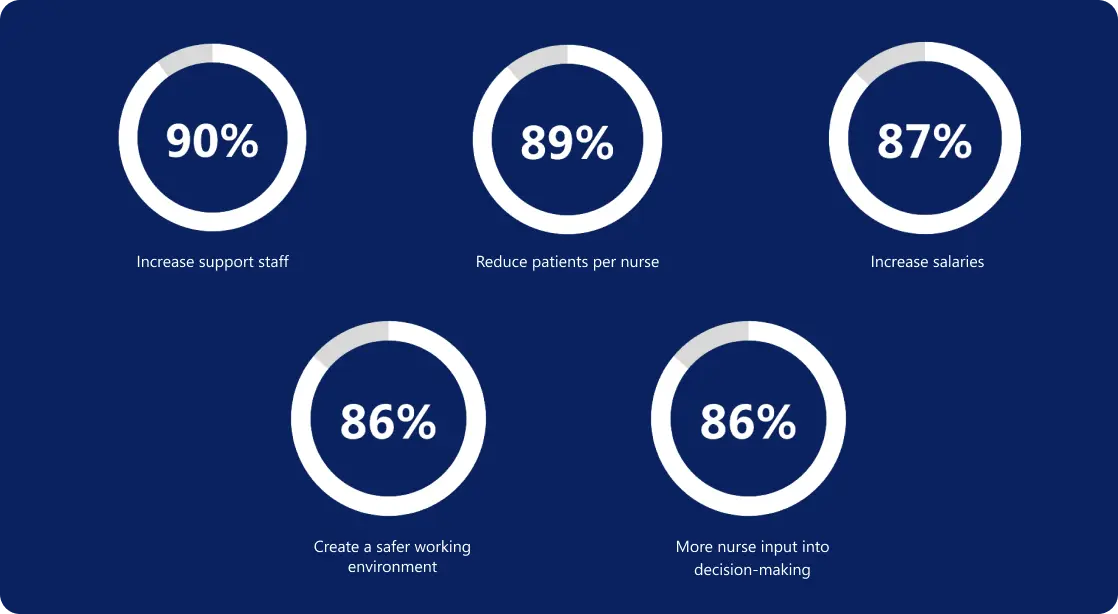
Nursing Job Satisfaction and Mental Health
The emotional well-being of nurses markedly improved in 2023, with a striking 81% reporting levels of healthy, very healthy, or somewhat healthy emotional states.
This represents an increase from the 66% reported in the previous year, signifying a positive shift in the emotional health within the nursing community.
Top strategies to alleviate burnout
While the stakes of stress and burnout are high within the nursing community due to the nature of the profession, recent research has identified actionable solutions. Here are the top strategies that would aid in mitigating the stressors of nurses’ daily work lives:
Major aspects of clinical work that lead to joy
The intrinsic reward of knowing that their efforts directly impact patient well-being and contribute to positive health outcomes is a powerful motivator for nurses.
When asked to rank aspects of their clinical work that brought them joy, making a difference was the top factor chosen by 22% of nurses.
In addition, patient interactions emerge as another significant factor, with 13% of nurses emphasizing the joy of meaningful connections with those under their care.
Caring and trusting coworkers (9%), flexible work schedule (9%), and positive work environment (8%) are additional aspects that lead to joy for nurses.
Impact of career satisfaction on nursing recommendations
Half of the nurses surveyed are extremely/somewhat likely to encourage others to join the profession. Career satisfaction, higher education, and work stress significantly influence the likelihood of recommending nursing.
Of nurses satisfied with their careers, 67% are inclined to recommend nursing, whereas only half of all nurses and a mere 6% of those unsatisfied are likely to do so.
The likelihood of recommending nursing rises with higher education levels, with 62% of nurses holding master’s degrees or above expressing readiness, compared to 47% of those with bachelor’s degrees or below.
Notably, work stress impacts recommendations, as 77% of nurses experiencing lower stress are prone to recommend nursing, contrasting sharply with the 37% among those facing higher work stress.
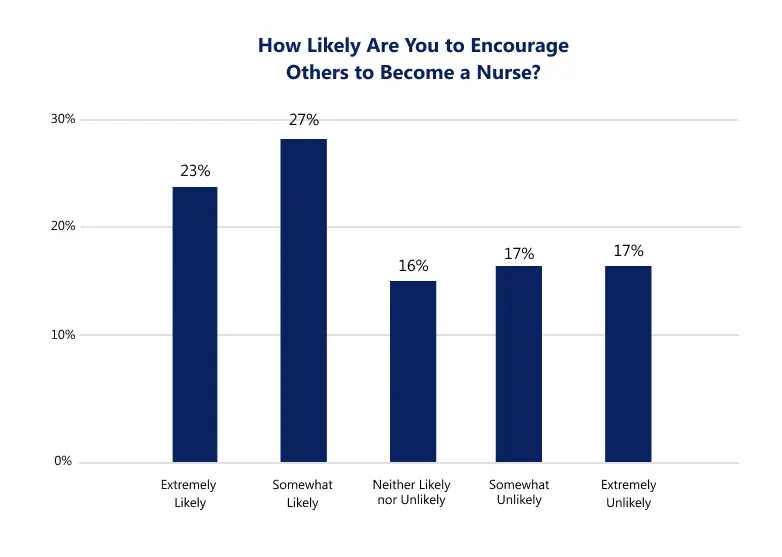
Impact of career satisfaction on nursing recommendations
Half of the nurses surveyed are extremely/somewhat likely to encourage others to join the profession. Career satisfaction, higher education, and work stress significantly influence the likelihood of recommending nursing.
Of nurses satisfied with their careers, 67% are inclined to recommend nursing, whereas only half of all nurses and a mere 6% of those unsatisfied are likely to do so.
The likelihood of recommending nursing rises with higher education levels, with 62% of nurses holding master’s degrees or above expressing readiness, compared to 47% of those with bachelor’s degrees or below.
Notably, work stress impacts recommendations, as 77% of nurses experiencing lower stress are prone to recommend nursing, contrasting sharply with the 37% among those facing higher work stress.

Bottom Line
Despite ongoing challenges, nursing maintains the highest ethical standards. The profession is experiencing a potential demographic shift with an increase in male representation. Full-time nursing positions have also increased, although challenges persist.
Beyond these nursing statistics lies a powerful truth — nursing is the cornerstone of a healthier, more caring society, and its impact is felt in the hearts of individuals and the well-being of communities alike.

